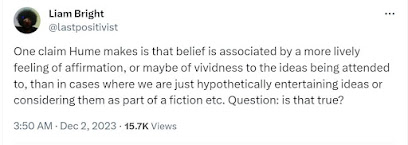The suspension of disbelief
This post, above, has me revisiting the concept of the “suspension of disbelief” that we talk about in the theater world.
To be up front, I hardly ever stop thinking about how flawed and inadequate “suspension of disbelief” is as an idea. Supposedly, it goes like this: when I am out in the street, in front of the theater, I am disposed to believe everything I see and to take it at face value. Then, as I move through the lobby, show my ticket, take my program and make my way to my seat – somewhere in that transition, I am supposed to have reset my default to disbelief. Then the challenge for the theatrical production is to have me set that disbelief aside, and toggle back to belief.
This idea acknowledges something but seems to miss the mark. Surely, the first part is right. I wouldn’t last long in the world if I didn’t generally, and pretty automatically, believe that the things around me were really happening. I could hardly cross the street to catch the E Line bus downtown to the theater.
But I don’t think I turn that off when I sit in my seat, waiting for the show to start.
Maybe the lights go up, a person enters the stage and says, “Two households, both alike in dignity …” and I think, “Hey, that’s my friend, Sandy! Great job, Sandy.” And the next thing you know, I’m thinking. “Oh, here comes Sampson and Gregory, these folks are really milking the laughs,” and so on into Act One, Scene One.
Then, maybe something about the way Lady Montague delivers the line, “Thou shalt not stir one foot to seek a foe,” grabs me and draws me in. I’m hooked. They have me. I don’t just buy it; I start to own it.
There is something going on there in the dark, but I don’t think it has to do with belief in the sense of, do I think these things are really happening or not, in the way you might say I believe two plus two equals four, or Olympia is the capital of Washington. What happens is I start feeling some way or another about the characters and the story being presented. That’s the definition of belief that the Tweet writer says philosopher David Hume holds. You have to feel it.
It’s a heart thing, not necessarily, or only, a head thing. I can still enjoy my assessments of my friend Sandy or the two chuckleheads playing Sampson and Gregory, along the way. That can be a big part of the fun of a show also. But what makes it work is when the person in the seat feels it, believe it or not.




Comments
Post a Comment